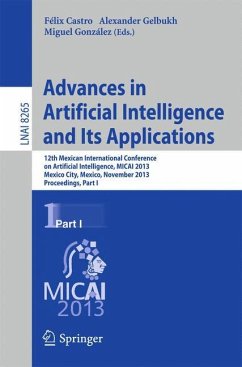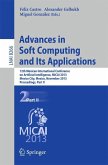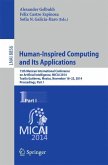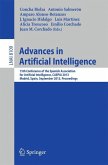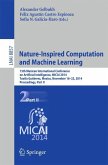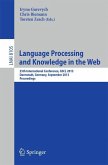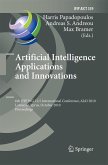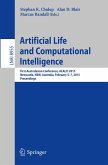Advances in Artificial Intelligence and Its Applications
12th Mexican International Conference, MICAI 2013, Mexico City, Mexico, November 24-30, 2013, Proceedings, Part I
Herausgegeben:Castro, Félix; Gelbukh, Alexander; González, Miguel
Advances in Artificial Intelligence and Its Applications
12th Mexican International Conference, MICAI 2013, Mexico City, Mexico, November 24-30, 2013, Proceedings, Part I
Herausgegeben:Castro, Félix; Gelbukh, Alexander; González, Miguel
- Broschiertes Buch
- Merkliste
- Auf die Merkliste
- Bewerten Bewerten
- Teilen
- Produkt teilen
- Produkterinnerung
- Produkterinnerung
The two-volume set LNAI 8265 and LNAI 8266 constitutes the proceedings of the 12th Mexican International Conference on Artificial Intelligence, MICAI 2013, held in Mexico City, Mexico, in November 2013. The total of 85 papers presented in these proceedings were carefully reviewed and selected from 284 submissions. The first volume deals with advances in artificial intelligence and its applications and is structured in the following five sections: logic and reasoning; knowledge-based systems and multi-agent systems; natural language processing; machine translation; and bioinformatics and…mehr
Andere Kunden interessierten sich auch für
![Advances in Soft Computing and Its Applications Advances in Soft Computing and Its Applications]() Advances in Soft Computing and Its Applications37,99 €
Advances in Soft Computing and Its Applications37,99 €![Human-Inspired Computing and its Applications Human-Inspired Computing and its Applications]() Human-Inspired Computing and its Applications37,99 €
Human-Inspired Computing and its Applications37,99 €![Advances in Artificial Intelligence Advances in Artificial Intelligence]() Advances in Artificial Intelligence37,99 €
Advances in Artificial Intelligence37,99 €![Nature-Inspired Computation and Machine Learning Nature-Inspired Computation and Machine Learning]() Nature-Inspired Computation and Machine Learning37,99 €
Nature-Inspired Computation and Machine Learning37,99 €![Language Processing and Knowledge in the Web Language Processing and Knowledge in the Web]() Language Processing and Knowledge in the Web34,99 €
Language Processing and Knowledge in the Web34,99 €![Artificial Intelligence Applications and Innovations Artificial Intelligence Applications and Innovations]() Artificial Intelligence Applications and Innovations83,99 €
Artificial Intelligence Applications and Innovations83,99 €![Artificial Life and Computational Intelligence Artificial Life and Computational Intelligence]() Artificial Life and Computational Intelligence37,99 €
Artificial Life and Computational Intelligence37,99 €-
-
-
The two-volume set LNAI 8265 and LNAI 8266 constitutes the proceedings of the 12th Mexican International Conference on Artificial Intelligence, MICAI 2013, held in Mexico City, Mexico, in November 2013. The total of 85 papers presented in these proceedings were carefully reviewed and selected from 284 submissions. The first volume deals with advances in artificial intelligence and its applications and is structured in the following five sections: logic and reasoning; knowledge-based systems and multi-agent systems; natural language processing; machine translation; and bioinformatics and medical applications. The second volume deals with advances in soft computing and its applications and is structured in the following eight sections: evolutionary and nature-inspired metaheuristic algorithms; neural networks and hybrid intelligent systems; fuzzy systems; machine learning and pattern recognition; data mining; computer vision and image processing; robotics, planning and scheduling and emotion detection, sentiment analysis and opinion mining.
Produktdetails
- Produktdetails
- Lecture Notes in Computer Science 8265
- Verlag: Springer / Springer Berlin Heidelberg / Springer, Berlin
- Artikelnr. des Verlages: 978-3-642-45113-3
- 2013
- Seitenzahl: 612
- Erscheinungstermin: 22. November 2013
- Englisch
- Abmessung: 235mm x 155mm x 33mm
- Gewicht: 914g
- ISBN-13: 9783642451133
- ISBN-10: 3642451136
- Artikelnr.: 39757299
- Herstellerkennzeichnung Die Herstellerinformationen sind derzeit nicht verfügbar.
- Lecture Notes in Computer Science 8265
- Verlag: Springer / Springer Berlin Heidelberg / Springer, Berlin
- Artikelnr. des Verlages: 978-3-642-45113-3
- 2013
- Seitenzahl: 612
- Erscheinungstermin: 22. November 2013
- Englisch
- Abmessung: 235mm x 155mm x 33mm
- Gewicht: 914g
- ISBN-13: 9783642451133
- ISBN-10: 3642451136
- Artikelnr.: 39757299
- Herstellerkennzeichnung Die Herstellerinformationen sind derzeit nicht verfügbar.
Some Properties of Logic N-GLukG.- The Inverse Method for Many-Valued Logics.- A Parametric Interpolation Framework for First-Order Theories.- Dalal's Revision without Hamming Distance.- Default Assumptions and Selection Functions: A Generic Framework for Non-monotonic Logics.- Soft Constraints for Lexicographic Orders.- Expressive Reasoning on Tree Structures: Recursion, Inverse Programs, Presburger Constraints and Nominals.- Completion-Based Automated Theory Exploration.- Possibilistic Minimal Models for Possibilistic Normal Programs.- Knowledge-Based Systems and Multi-Agent Systems Estimating the Number of Test Cases for Active Rule Validation.- A Dynamic Multi-Expert Multi-Criteria Decision Making Model for Risk Analysis.- An Architecture for Cognitive Modeling to Support Real-Time Adaptation and Motivational Responses in Video Games.- Semantic Representation of CAD Models Based on the IGES Standard.- Complexity of Verification of Fuzzy Multi-Agent Systems.- Using Activity Theory and Causal Diagrams for Designing MultiAgent Systems That Assist Human Activities.- Challenges in Ontology Alignment and Solution to the Contradictory Evidence Problem.- Simple Window Selection Strategies for the Simplified Lesk Algorithm for Word Sense Disambiguation.- Disambiguating Wikipedia Articles on the Basis of plWordNet Lexico-semantic Relations.- Recognising Compositionality of Multi-Word Expressions in the Wordnet Oriented Perspective.- Automatic Processing of Linguistic Data as a Feedback for Linguistic Theory.- Interval Semi-supervised LDA: Classifying Needles in a Haystack.- A Reverse Dictionary Based on Semantic Analysis Using WordNet.- Applying Rogerian Psychologist in Human-Computer Interaction: A Case Study.- HuLaPos 2.0 - Decoding Morphology.- Hybrid Text Segmentation for Hungarian Clinical Records.- Detection and Expansion of Abbreviations in Hungarian Clinical Notes.- Composite Event Indicator Processing in Event Extraction for Non-configurationalLanguage.- Exploration of a Rich Feature Set for Automatic Term Extraction.- A Pseudo-Relevance Feedback Based Method to Find Comprehensive Web Documents.- Enhancing Sentence Ordering by Hierarchical Topic Modeling for Multi-document Summarization.- An Enhanced Arabic OCR Degraded Text Retrieval Model.- ELEXR: Automatic Evaluation of Machine Translation Using Lexical Relationships.- Modeling Persian Verb Morphology to Improve English-Persian Machine Translation.- An XML Based TBX Framework to Represent Multilingual SNOMED CT for Translation.- The Twin Hypotheses - Brain Code and the Fundamental Code Unit: Towards Understanding the Computational Primitive Elements of Cortical Computing.- Predicting Metabolic Syndrome with Neural Networks.- Homogeneous Population Solving the Minimal Perturbation Problem in Dynamic Scheduling of Surgeries.- CUP Classification Based on a Tree Structure with MiRNA Feature Selection.- Machine Learning Techniques Applied to the Cleavage Site Prediction Problem.- Human Heart Segmentation Based on Differential Evolution and Active Contours with Shape Prior.- Detection of Human Retina Images Suspect of Glaucoma through the Vascular Bundle Displacement in the Optic Disc.- Blood Vessel Segmentation in Retinal Images Using Lattice Neural Networks.- A Bayesian and Minimum Variance Technique for Arterial Lumen Segmentation in Ultrasound Imaging.- Detection of Masses in Mammogram Images Using Morphological Operators and Markov Random Fields.- A New Collection of Preprocessed Digital Mammograms.
Some Properties of Logic N-GLukG.- The Inverse Method for Many-Valued Logics.- A Parametric Interpolation Framework for First-Order Theories.- Dalal's Revision without Hamming Distance.- Default Assumptions and Selection Functions: A Generic Framework for Non-monotonic Logics.- Soft Constraints for Lexicographic Orders.- Expressive Reasoning on Tree Structures: Recursion, Inverse Programs, Presburger Constraints and Nominals.- Completion-Based Automated Theory Exploration.- Possibilistic Minimal Models for Possibilistic Normal Programs.- Knowledge-Based Systems and Multi-Agent Systems Estimating the Number of Test Cases for Active Rule Validation.- A Dynamic Multi-Expert Multi-Criteria Decision Making Model for Risk Analysis.- An Architecture for Cognitive Modeling to Support Real-Time Adaptation and Motivational Responses in Video Games.- Semantic Representation of CAD Models Based on the IGES Standard.- Complexity of Verification of Fuzzy Multi-Agent Systems.- Using Activity Theory and Causal Diagrams for Designing MultiAgent Systems That Assist Human Activities.- Challenges in Ontology Alignment and Solution to the Contradictory Evidence Problem.- Simple Window Selection Strategies for the Simplified Lesk Algorithm for Word Sense Disambiguation.- Disambiguating Wikipedia Articles on the Basis of plWordNet Lexico-semantic Relations.- Recognising Compositionality of Multi-Word Expressions in the Wordnet Oriented Perspective.- Automatic Processing of Linguistic Data as a Feedback for Linguistic Theory.- Interval Semi-supervised LDA: Classifying Needles in a Haystack.- A Reverse Dictionary Based on Semantic Analysis Using WordNet.- Applying Rogerian Psychologist in Human-Computer Interaction: A Case Study.- HuLaPos 2.0 - Decoding Morphology.- Hybrid Text Segmentation for Hungarian Clinical Records.- Detection and Expansion of Abbreviations in Hungarian Clinical Notes.- Composite Event Indicator Processing in Event Extraction for Non-configurationalLanguage.- Exploration of a Rich Feature Set for Automatic Term Extraction.- A Pseudo-Relevance Feedback Based Method to Find Comprehensive Web Documents.- Enhancing Sentence Ordering by Hierarchical Topic Modeling for Multi-document Summarization.- An Enhanced Arabic OCR Degraded Text Retrieval Model.- ELEXR: Automatic Evaluation of Machine Translation Using Lexical Relationships.- Modeling Persian Verb Morphology to Improve English-Persian Machine Translation.- An XML Based TBX Framework to Represent Multilingual SNOMED CT for Translation.- The Twin Hypotheses - Brain Code and the Fundamental Code Unit: Towards Understanding the Computational Primitive Elements of Cortical Computing.- Predicting Metabolic Syndrome with Neural Networks.- Homogeneous Population Solving the Minimal Perturbation Problem in Dynamic Scheduling of Surgeries.- CUP Classification Based on a Tree Structure with MiRNA Feature Selection.- Machine Learning Techniques Applied to the Cleavage Site Prediction Problem.- Human Heart Segmentation Based on Differential Evolution and Active Contours with Shape Prior.- Detection of Human Retina Images Suspect of Glaucoma through the Vascular Bundle Displacement in the Optic Disc.- Blood Vessel Segmentation in Retinal Images Using Lattice Neural Networks.- A Bayesian and Minimum Variance Technique for Arterial Lumen Segmentation in Ultrasound Imaging.- Detection of Masses in Mammogram Images Using Morphological Operators and Markov Random Fields.- A New Collection of Preprocessed Digital Mammograms.

